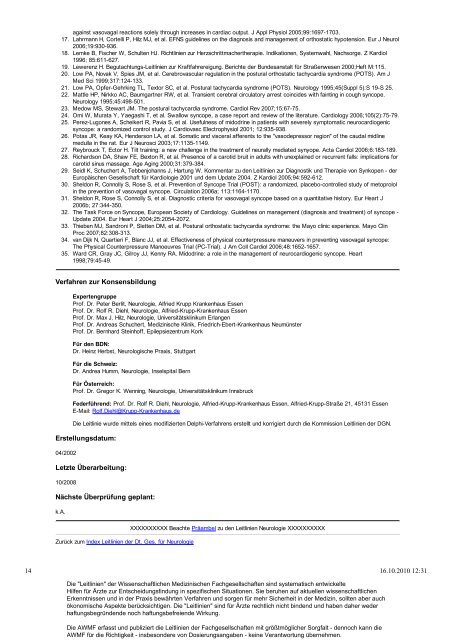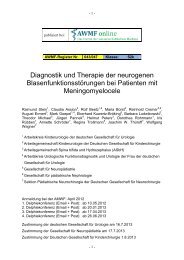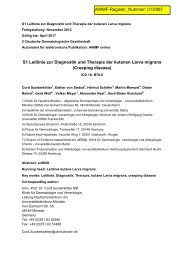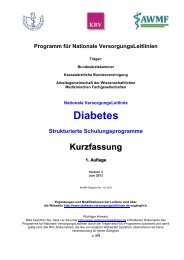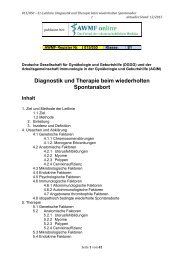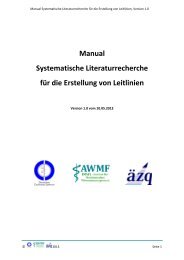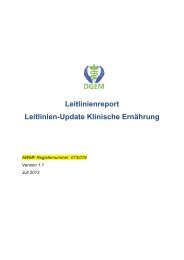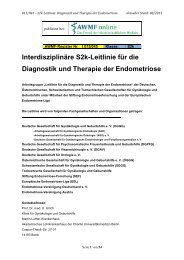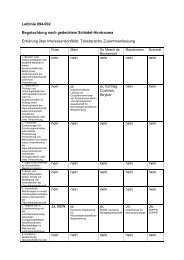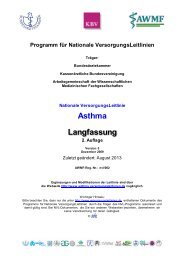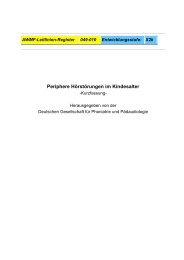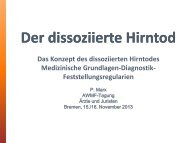AWMF online Synkopen
AWMF online Synkopen
AWMF online Synkopen
Erfolgreiche ePaper selbst erstellen
Machen Sie aus Ihren PDF Publikationen ein blätterbares Flipbook mit unserer einzigartigen Google optimierten e-Paper Software.
17.<br />
18.<br />
19.<br />
20.<br />
21.<br />
22.<br />
23.<br />
24.<br />
25.<br />
26.<br />
27.<br />
28.<br />
29.<br />
30.<br />
31.<br />
32.<br />
33.<br />
34.<br />
35.<br />
against vasovagal reactions solely through increases in cardiac output. J Appl Physiol 2005;99:1697-1703.<br />
Lahrmann H, Cortelli P, Hilz MJ, et al. EFNS guidelines on the diagnosis and management of orthostatic hypotension. Eur J Neurol<br />
2006;19:930-936.<br />
Lemke B, Fischer W, Schulten HJ. Richtlinien zur Herzschrittmachertherapie. Indikationen, Systemwahl, Nachsorge. Z Kardiol<br />
1996; 85:611-627.<br />
Lewerenz H. Begutachtungs-Leitlinien zur Kraftfahrereigung. Berichte der Bundesanstalt für Straßenwesen 2000;Heft M:115.<br />
Low PA, Novak V, Spies JM, et al. Cerebrovascular regulation in the postural orthostatic tachycardia syndrome (POTS). Am J<br />
Med Sci 1999;317:124-133.<br />
Low PA, Opfer-Gehrking TL, Textor SC, et al. Postural tachycardia syndrome (POTS). Neurology 1995;45(Suppl 5):S 19-S 25.<br />
Mattle HP, Nirkko AC, Baumgartner RW, et al. Transient cerebral circulatory arrest coincides with fainting in cough syncope.<br />
Neurology 1995;45:498-501.<br />
Medow MS, Stewart JM. The postural tachycardia syndrome. Cardiol Rev 2007;15:67-75.<br />
Omi W, Murata Y, Yaegashi T, et al. Swallow syncope, a case report and review of the literature. Cardiology 2006;105(2):75-79.<br />
Perez-Lugones A, Scheikert R, Pavia S, et al. Usefulness of midodrine in patients with severely symptomatic neurocardiogenic<br />
syncope: a randomized control study. J Cardiovasc Electrophysiol 2001; 12:935-938.<br />
Potas JR, Keay KA, Henderson LA, et al. Somatic and visceral afferents to the "vasodepressor region" of the caudal midline<br />
medulla in the rat. Eur J Neurosci 2003;17:1135-1149.<br />
Reybrouck T, Ector H. Tilt training: a new challenge in the treatment of neurally mediated synyope. Acta Cardiol 2006;6:183-189.<br />
Richardson DA, Shaw FE, Bexton R, et al. Presence of a carotid bruit in adults with unexplained or recurrent falls: implications for<br />
carotid sinus massage. Age Aging 2000;31:379-384.<br />
Seidl K, Schuchert A, Tebbenjohanns J, Hartung W. Kommentar zu den Leitlinien zur Diagnostik und Therapie von <strong>Synkopen</strong> - der<br />
Europäischen Gesellschaft für Kardiologie 2001 und dem Update 2004. Z Kardiol 2005;94:592-612.<br />
Sheldon R, Connolly S, Rose S, et al. Prevention of Syncope Trial (POST): a randomized, placebo-controlled study of metoprolol<br />
in the prevention of vasovagal syncope. Circulation 2006a; 113:1164-1170.<br />
Sheldon R, Rose S, Connolly S, et al. Diagnostic criteria for vasovagal syncope based on a quantitative history. Eur Heart J<br />
2006b; 27:344-350.<br />
The Task Force on Syncope, European Society of Cardiology. Guidelines on management (diagnosis and treatment) of syncope -<br />
Update 2004. Eur Heart J 2004;25:2054-2072.<br />
Thieben MJ, Sandroni P, Sletten DM, et al. Postural orthostatic tachycardia syndrome: the Mayo clinic experience. Mayo Clin<br />
Proc 2007;82:308-313.<br />
van Dijk N, Quartieri F, Blanc JJ, et al. Effectiveness of physical counterpressure maneuvers in preventing vasovagal syncope:<br />
The Physical Counterpressure Manoeuvres Trial (PC-Trial). J Am Coll Cardiol 2006;48:1652-1657.<br />
Ward CR, Gray JC, Gilroy JJ, Kenny RA. Midodrine: a role in the management of neurocardiogenic syncope. Heart<br />
1998;79:45-49.<br />
Verfahren zur Konsensbildung<br />
Expertengruppe<br />
Prof. Dr. Peter Berlit, Neurologie, Alfried Krupp Krankenhaus Essen<br />
Prof. Dr. Rolf R. Diehl, Neurologie, Alfried-Krupp-Krankenhaus Essen<br />
Prof. Dr. Max J. Hilz, Neurologie, Universitätsklinikum Erlangen<br />
Prof. Dr. Andreas Schuchert, Medizinische Klinik, Friedrich-Ebert-Krankenhaus Neumünster<br />
Prof. Dr. Bernhard Steinhoff, Epilepsiezentrum Kork<br />
Für den BDN:<br />
Dr. Heinz Herbst, Neurologische Praxis, Stuttgart<br />
Für die Schweiz:<br />
Dr. Andrea Humm, Neurologie, Inselspital Bern<br />
Für Österreich:<br />
Prof. Dr. Gregor K. Wenning, Neurologie, Universitätsklinikum Innsbruck<br />
Federführend: Prof. Dr. Rolf R. Diehl, Neurologie, Alfried-Krupp-Krankenhaus Essen, Alfried-Krupp-Straße 21, 45131 Essen<br />
E-Mail: Rolf.Diehl@Krupp-Krankenhaus.de<br />
Die Leitlinie wurde mittels eines modifizierten Delphi-Verfahrens erstellt und korrigiert durch die Kommission Leitlinien der DGN.<br />
Erstellungsdatum:<br />
04/2002<br />
Letzte Überarbeitung:<br />
10/2008<br />
Nächste Überprüfung geplant:<br />
k.A.<br />
Zurück zum Index Leitlinien der Dt. Ges. für Neurologie<br />
XXXXXXXXXX Beachte Präambel zu den Leitlinien Neurologie XXXXXXXXXX<br />
14 16.10.2010 12:31<br />
Die "Leitlinien" der Wissenschaftlichen Medizinischen Fachgesellschaften sind systematisch entwickelte<br />
Hilfen für Ärzte zur Entscheidungsfindung in spezifischen Situationen. Sie beruhen auf aktuellen wissenschaftlichen<br />
Erkenntnissen und in der Praxis bewährten Verfahren und sorgen für mehr Sicherheit in der Medizin, sollten aber auch<br />
ökonomische Aspekte berücksichtigen. Die "Leitlinien" sind für Ärzte rechtlich nicht bindend und haben daher weder<br />
haftungsbegründende noch haftungsbefreiende Wirkung.<br />
Die <strong>AWMF</strong> erfasst und publiziert die Leitlinien der Fachgesellschaften mit größtmöglicher Sorgfalt - dennoch kann die<br />
<strong>AWMF</strong> für die Richtigkeit - insbesondere von Dosierungsangaben - keine Verantwortung übernehmen.


